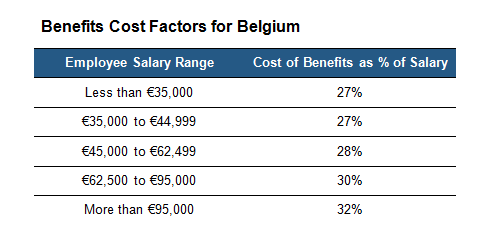Compensation managers are rightly focused on the cost of cash and equity awards, but understanding the cost of benefits allows them to more fully assess total rewards spend.

Are we competitive in the marketplace for talent? It's a question that compensation and human resources professionals get asked by business leaders on a regular basis. However, because benefits often comprise such a large part of an employee's total rewards package, answering this question by simply looking at total direct compensation can be misleading, especially in benefits rich countries.
To help clients address this challenge, the Radford Global Technology Survey now includes information on the total cost of benefits in more than 20 countries, with data arriving for a total of 40 countries by the end of July 2016. This data, provided by the Aon Hewitt Global Benefits team, is presented as a percentage of median base salary in local currencies on a job-by-job basis, and is highly customized to vary by job level to reflect variations in benefits costs as employee pay levels rise. Importantly, the data also reflects a specialized view of technology sector data from the Aon Hewitt Greater Insight benefits platform, making it an unmatched resource for Radford clients.
This new feature also includes both mandatory benefits— in other words, those required by law— as well as supplemental benefits, such as retirement, health and disability offerings that go beyond what is required by local law and are partially or fully funded by employers. With this information in hand, compensation managers now have a far more complete picture of the competitive landscape using a total rewards perspective.
Why Look at Total Rewards?
The workplace has evolved. In order to effectively hire, retain and engage employees, compensation managers must understand the total rewards opportunity for their workers. Doing so will bring a more holistic perspective to business decisions like the competitiveness question we posed at the beginning of this article. Furthermore, the aggressive hiring landscape for technology talent is forcing HR departments to become more integrated in their approach to communicating a company's employee value proposition to current and prospective employees. This drives increased collaboration between compensation, benefits and recruiting professionals.
In our view, total rewards figures are valuable to compensation managers for three main reasons:
- It gives compensation managers a broader perspective by showing the relative cost of compensation vs. benefits. Evaluating the cost of benefits along with compensation may influence target pay positioning. For instance, a company whose benefit costs are on the high end may need to factor that into their planning with cash and/or equity incentives.
- Benefits often represent a significant portion of the total rewards cost— up to the cost of base salary in some countries for certain job levels. Ignoring these costs obscures the full picture of how employees are compensated.
- It's a critical data point for workforce planning; the full cost of employment is a key factor in selecting locations for growth. In Belgium, for example, statutory benefits costs (a large part of the overall benefits provided in the country) increase as a percent of base salary with each successive job level and there is no salary cap to limit benefit costs. If a company is choosing between two locations for placing high-level jobs, a significant increase in workforce spend in one country vs. the other will at least be one data point in the business decision of where to locate jobs.
By displaying benefits data by job level, clients can more clearly see differences in employer benefits practices and the impact of local laws for each country. For example, there are some countries where the cost of benefits increases with each successive step in salary, such as Belgium in the chart below. However, in other countries, like the United States (US), benefits costs decrease as job levels and salaries get higher. In the US, this is due to statutory limits on certain benefits above certain pay thresholds, so actual costs no longer increase, making them decline as a percent of higher salaries. An example is a Canadian RRSP matching plan that caps off at Canada Revenue Agency contribution limits.

Looking at the total cost of benefits by job level and salary range helps business leaders understand why benefits might be more expensive than their competitors in the same country. This might happen if, for example, the distribution of their workforce has higher-earning employees in a country like Belgium.
Looking Ahead
The total cost of benefits is an important part of the total rewards equation. Without benefits data, the true cost of your workforce could be underestimated by as much as 30% or more. It's usually not the job of compensation managers to make decisions about benefits, but incorporating the total cost of benefits into estimates of total rewards figures is a valuable step forward in understanding the full competitive position of your company relative to your peers.
Radford has partnered with the Aon Hewitt Global Benefits team to provide this data. For specific questions about benefits costs or detailed information on benefits, please contact Marie-Eve Ferland for the Americas and Carl Redondo for Europe, the Middle East and Asia. If you are interested in participating in the Radford Global Technology Survey, please contact sales@radford.com.
Related Articles